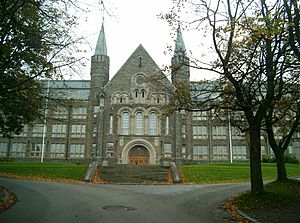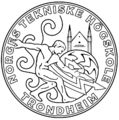Norwegian Institute of Technology facts for kids
The Norwegian Institute of Technology (in Norwegian: Norges tekniske høgskole, or NTH) was a special school for science and technology in Trondheim, Norway. It opened in 1910 and worked as its own university for 58 years. Later, it joined the University of Trondheim as a separate college.
In 1996, NTH changed its name and structure. Its old departments are now part of the Norwegian University of Science and Technology (NTNU).
NTH mainly trained people to become master-level engineers and architects. In 1992, NTH had over 7,600 students and nearly 1,600 staff. It helped many students become skilled engineers and architects. The school was quite large, covering about 260,000 square meters (64 acres).
Today, the former NTH campus is known as Gløshaugen. This is the name of the area where the university buildings are located.
Contents
History of the Norwegian Institute of Technology
The idea to create a national technology college in Norway began in 1900. The Norwegian parliament, called the Storting, decided to build it. There was a big discussion about where it should be. Many thought the capital city, Kristiania (now Oslo), was the best place.
However, the parliament chose Trondheim for the new school. This was partly because Trondheim already had a good technical college. It also fit a plan to spread important institutions across the country, not just in the capital.
The main building of NTH, called Hovedbygningen, was designed by architect Bredo Greve. It was built using strong granite blocks in a style called National Romantic style.
When NTH first opened in 1900, it had five main study areas:
- Architecture and city planning
- Civil engineering (building roads, bridges, etc.)
- Mechanical engineering (designing machines, ships, and ship engines)
- Electrical engineering (working with electricity)
- Chemistry (including general chemistry and electro-chemistry)
What Students Studied at NTH
NTH offered many different subjects for students interested in technology and science. Before it became part of NTNU, it had several main faculties, which are like big departments.
Students could study things like:
- Architecture: Learning how to design buildings and plan cities.
- Earth Science and Metallurgy: Studying rocks, minerals, and how to work with metals.
- Civil Engineering: Focusing on building structures, roads, and water systems.
- Electrical Engineering and Computer Science: Working with electricity, telecommunications, and computer systems.
- Chemistry and Chemical Engineering: Exploring different types of chemistry and how to use them in industry.
- Mechanical Engineering: Dealing with machines, energy, and how things move.
- Physics and Mathematics: The basic sciences that support all engineering.
- Marine Technology: Designing ships and other things that work in the ocean.
- Economics and Industrial Management: Learning about business and how to manage organizations.
NTH also had a special library, the Technical University Library of Norway. It was a national resource for technology and architecture.
Famous People Who Studied at NTH
Many talented people studied at the Norwegian Institute of Technology. They went on to do amazing things in science, engineering, and business. Here are a few examples:
- Ivar Giaever: A mechanical engineer and physicist who won the Nobel Prize in 1973 for his work in physics.
- Lars Onsager: A chemical engineer who won the Nobel Prize in 1968, also for his work in chemistry.
- Fred Kavli: A physicist and businessman who became famous for his work in sensor technology. He also gave a lot of money to support science.
- Paal Kibsgaard: A petroleum engineer who became the head of a very large oilfield services company called Schlumberger.
- Leif Tronstad: A chemist who was important in planning a famous World War II mission called Operation Gunnerside. This mission stopped Nazi Germany from getting materials for an atomic bomb.
- Vebjørn Tandberg: An electronics engineer who created a well-known company that made radios, tape recorders, and televisions.
- John Ugelstad: A chemical engineer known for creating tiny, perfect beads used in medicine and other fields.
- Vegard Wollan and Alf Egil Bogen: Both electronics engineers who helped create the very popular Atmel AVR microcontroller, a tiny computer chip.
Companies Started from NTH Research
NTH was not just a place for learning; it also helped create many new companies. Its research and the work of its spin-off company, SINTEF, led to many important businesses. These companies often focused on new technologies.
Some examples of companies that came from NTH's influence include:
- 3d-Radar AS: This company developed advanced radar technology to map things underground in 3D.
- Atmel Norway: This company designed and created the Atmel AVR computer chips.
- Fast Search & Transfer (FAST): They developed powerful search engines for the internet and company networks.
- GE Vingmed Ultrasound: This company makes medical ultrasound systems for imaging inside the body.
- Nordic Semiconductor ASA: They design special computer chips for wireless communication.
- Q-Free ASA: This company creates radio systems for things like toll roads, parking, and ticketing.
- SINTEF: This is a large research organization that works closely with NTNU. It helps turn scientific ideas into useful products and services.
These companies show how NTH's focus on science and engineering helped create new jobs and technologies in Norway and around the world.
Images for kids





